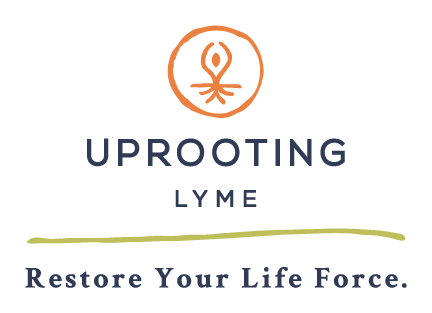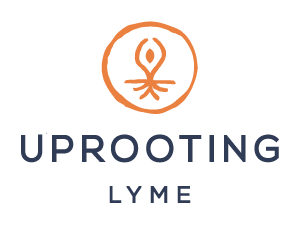
Viral Re-Activation & Lyme – the Chicken or the Egg?
What Is Viral Re-Activation?
Viral reactivation is the process by which a latent virus switches to an active phase of replication.
Many viruses are known to exist as latent infections in the body, including:
- Herpes Simplex 1 & 2 (oral and genital herpes),
- Varicella Zoster (the cause of chickenpox and shingles)
- Epstein–Barr virus
- Cytomegalovirus (associated with irritable bowel syndrome)
- Human Herpesvirus 6 and 7
- Kaposi’s sarcoma-associated herpesvirus
- Parvovirus; and
- Adenovirus.
Reactivation may be provoked by a variety of factors that influence the cellular environment, the body’s “inner ecology” if you will, that in turn awaken replication of a virus that has been latent inside the cell.
Viral reactivation is associated with several factors, including new viral infection (such as Covid), physical changes (such as fever, change of diet, or menstruation), or compromised immunity. There are many possible contributors to immune system impairment, including stress, poor sleep, or – you guessed it! – chronic bacterial infection such as Lyme disease.
When the latent virus converts to a mode of active replication, it grows and spreads within the body, becoming an added challenge to the immune system and a burden to vitality. It may even be a reason that we are not able to heal fully from Lyme (or other illnesses such as Covid), until we address the reactivated virus head on.
Who Has Latent Viruses? Nearly Everyone.
Researchers estimate that more than 90% of the population has Epstein-Barr Virus, the virus that causes mononucleosis and is often responsible for the development of Chronic Fatigue Syndrome and Fibromyalgia when left untreated.
The World Health Organization estimates that 13.2% of the world’s population has HSV-2 and 66.6% have HSV-1.
Suffice it to say, virtually everyone has 1 or more latent virus in their body. They are successfully held in check when the immune system is healthy. But when a person has Lyme, co-infections, or Covid-19, there can be a significant reduction in T cells. T cells are the immune cells that typically keep these viruses in a latent form. The new infection compromises the immune system, especially when it doesn’t resolve quickly, which can reactivate a latent virus. That reactivated virus generates new symptoms and adds to the energetic and immune system burden. This can snowball into a layered, multi-infection chronic illness in which the person becomes more vulnerable to other opportunistic infections that are more complicated to diagnose and treat. Yikes!
Symptoms of Viral Reactivation
Common symptoms of viral reactivation are fatigue, low-grade fevers, headache, swollen lymph glands, sore throat, brain fog, muscle aches, irritability, a general sense of feeling “run down,” and poor tolerance to stress.
Of course, these symptoms overlap with chronic infections such as Lyme disease, so it is challenging to know what to attribute these symptoms to. This can lead to confusion, and spending time and resources treating the wrong thing!
Reactivated viruses, when left untreated, can cause severe progressive illness. They can play a primary role in the development of Chronic Fatigue Syndrome, certain cancers, Multiple Sclerosis and Long Covid. For example, a recent study looked at the connection between Long COVID and EBV and found that 66.7% of the study subjects with Long COVID were positive for EBV reactivation.
A Case Example
Earlier this year, Sarah, a 39-year-old woman came to me for treatment of re-activated Epstein-Barr virus. She complained of swollen glands, body aches, headache and exhaustion that peaked in intensity every afternoon. In the morning and evening she was functional, but every afternoon her energy crashed, and she became couch-bound and ill.
About 1 year prior in the springtime she had developed joint aches, brain fog and fatigue. These symptoms came on gradually and worsened over the summer. She went to her doctor and in August was diagnosed with Lyme disease. She was given a 1-month course of Doxycycline, during which time her symptoms improved at first, but following completion of the treatment, her symptoms began to creep back. The pain, fatigue and poor cognition became even more pronounced to the point that she became concerned about her job performance, and her ability to take proper care of her 4-year-old son.
Since her doctor was not willing to prescribe any more antibiotics, she sought the help of a well-respected Lyme literate MD. She did several more rounds of antibiotics including Doxycycline, Bactrim, and Nystatin. Her integrative doctor also prescribed many herbals and vitamin supplements including probiotics, Monolaurin, and herbal tinctures for immune support.
Through testing they discovered that she was positive for Epstein-Barr virus, Lyme-borreliosis and Rocky Mountain Spotted Fever. Her CD 57 natural killer T-cell count was low at 24 (60-360).
Unfortunately, after completing each course of antibiotics, her symptoms of fatigue, joint and muscle aches and brain fog would return, and she began to develop a headache, sore throat and swollen glands as well.
On the upside, her digestive system remained strong. She ate a clean diet that was mostly vegetarian and avoided gluten, sugar, and excess carbs. She was very clear that she felt worse if gluten or sugar slipped into her food intake. Also, aside from her health issues, her stress levels overall were low. These factors likely are what prevented the development of a bigger health crisis. Yet despite her healthy lifestyle, she remained unable to get better.
She sought my help to get out of the loop of antibiotic use, and to move away from the long list of supplements that she was currently taking. She was also taking Lexapro since having a bout with post-partum depression 4 years prior. She had found it helpful at the time but had begun to wonder, “Do I need to take this forever?”
Herbal Solutions For Viral Re-Activation
There were 2 herbal remedies that we used to create a breakthrough in Sarah’s cycle of illness caused by the Lyme disease and viral reactivation:
- The first was a liposomal essential oil remedy called Going Viral. The active ingredients are organic essential oils of melissa, hyssop, cajeput, tea tree, eucalyptus, cinnamon leaf and thyme. Essential oils such as these inhibit the growth and replication of viruses and are non-toxic when taken as a nano-emulsion in therapeutic dosages.
- I also prescribed an herbal formula that addressed the recurring Lyme and Rocky Mountain Spotted Fever infections, the re-activated Epstein-Barr Virus, and supported her immune system and the alleviation of her symptoms. Her formula contained:
Bupleurum – an herb that supports liver detoxification and is used in Chinese medicine to release latent pathogens that are stuck in the body and not resolving;
Isatis – an important anti-viral herb that clears the lymph and sore throat, reduces glandular swelling, and supports the reduction of the viral load;
Forsythia – a top antiviral and antibacterial herb that releases unresolved pathogens and supports completion of the healing process;
Olive leaf – an excellent antibacterial, antiviral and antifungal herb to support her transition off the pharmaceutical antibiotics;
Cat’s Claw – a stellar South American herb that treats persistent antibiotic resistant Lyme, especially with joint pain as a major manifestation; Cat’s Claw also supports the immune system’s ability to fight infection while lowering inflammation;
Japanese knotweed – among the most effective herbs for the treatment of Lyme and its classical manifestations of fatigue, joint pain and brain fog; it is also anti-inflammatory and detoxifying;
Cryptolepsis – this traditional African herbs is highly effective at binding viruses and Lyme-borreliosis (including Covid according to a recent study);
Scrophularia – a favorite for clearing lymph, reducing lymph gland swelling, and clearing toxins and infections from the body;
Astragalus – for immune system support to restore T cell counts and overcome infections;
Baical Skullcap – an excellent broad-spectrum anti-microbial and anti-viral herb; support detoxification and calms chronic inflammation.
Within about 2 months of taking the Going Viral essential oil remedy, the herbal decoction, alongside an adrenal glandular supplement, she began to feel “relatively energetic.” She had stopped the antibiotic regimen and all of the supplements from the prior protocol except for Vitamin D. The migratory pains and headaches had ceased, and the brain fog was less. There were still days that her energy crashed, and she had to be careful not to overdo activity, but clearly, she was making steady gains.
After a few more months on the regimen, she reported feeling “the best she’s felt in more than a year.” We had begun to support her thyroid as well with natural supplementation and were ready to begin a slow weaning process off the Lexapro. She no longer had headaches or joint pains; with a few exceptions related to stress her sore throat and swollen glands did not occur. Her stamina for activity, exercise, and cognitive work was much better. We continue to support her immune system and use herbal and essential oil remedies to prevent recurrence of Lyme and viral infections, and to support her mood and hormone balance.
Herbal Medicines Have Broad-Spectrum Action
One of the great benefits of using herbal medicines for healing is that they work on multiple viruses, and even on other bacteria, fungal, and parasitic microbes as well. So even if you don’t know exactly which viruses or microbes are active, the herbs can be effective.
Another benefit is the lack of toxicity to the liver, kidney, and other cells. In fact, rather than taxing the body to reap their antimicrobial benefits, these herbs and essential oils support the body’s ability to rid itself of the effects of die-off. This equates to safety for people of all ages, and a relatively easy path to healing, as was demonstrated by Sarah’s story.
Finally, these botanical medicines, especially when used in synergistic combinations, restore the immune system to be able to regain control of the disease-causing elements within the body. This means that we can regain our health and remain resilient against inevitable exposures to infection when they come.
Sources:
- Allahverdiyev A, Duran N, Ozguven M and Koltas S: Antiviral activity of the volatile oils of Melissa officinalis L. against Herpes simplex virus type-2, Phytomedicine. 11(7-8):2004; 657–661.
- Astani A, Navid MH, and Schnitzler P. Attachment and penetration of acyclovir-resistant herpes simplex virus are inhibited by Melissa officinalis extract. Phytother Res. England; 2014;28(10):1547-52.
- Astani A, Reichling J, and Schnitzler P. Melissa officinalis extract inhibits attachment of herpes simplex virus in vitro. Chemotherapy. Switzerland; 2012;58(1):70-7.
- Borquaye LS, Gasu EN, Ampomah GB, Kyei LK, Amarh MA, Mensah CN, Nartey D, Commodore M, Adomako AK, Acheampong P, Mensah JO, Mormor DB, Aboagye CI. Alkaloids from Cryptolepis sanguinolenta as Potential Inhibitors of SARS-CoV-2 Viral Proteins: An In Silico Study. Biomed Res Int. 2020 Sep 22;2020:5324560. doi: 10.1155/2020/5324560. PMID: 33029513; PMCID: PMC7512045.
- Choi HJ. Chemical Constituents of Essential Oils Possessing Anti-Influenza A/WS/33 Virus Activity. Osong Public Health Res Perspect. 2018;9(6):348–353. doi:10.24171/j.phrp.2018.9.6.09. https://www.ncbi.nlm.nih.gov/pmc/articles/PMC6296812/
- Gold JE, Okyay RA, Licht WE, Hurley DJ. Investigation of Long COVID Prevalence and Its Relationship to Epstein-Barr Virus Reactivation. Pathogens. 2021 Jun 17;10(6):763. doi: 10.3390/pathogens10060763. PMID: 34204243; PMCID: PMC8233978.
- He XF, Pan WD, Yao YL, Zhang HM. Recent highlights of Chinese herbs in treatment of allergic disease: Acting via mitogen-activated protein kinase signal pathway. Chin J Integr Med. 2017 Aug;23(8):570-573. doi: 10.1007/s11655-016-2526-x. Epub 2016 Jul 26. PMID: 27460493.
- Lopetuso LR, Ianiro G, Scaldaferri F, Cammarota G, Gasbarrini A. Gut Virome and Inflammatory Bowel Disease. 2016 Jul;22(7):1708-12. doi: 10.1097/MIB.0000000000000807
- Park CH, Kim DH, Park MH, Kim MK, Kim ND, Kim CM, Tanaka T, Yokozawa T, Chung HY, Moon HR. Chinese prescription Kangen-karyu and Salviae Miltiorrhizae Radix improve age-related oxidative stress and inflammatory response through the PI3K/Akt or MAPK pathways. Am J Chin Med. 2014;42(4):987-1005. doi: 10.1142/S0192415X14500621. PMID: 25004887.
- Thorley-Lawson, DA. EBV Persistence—Introducing the Virus. Current Topics in Microbiology and Immunology. 2015;390(Pt 1):151-209. doi: 10.1007/978-3-319-22822-8_8
- Traylen CM, Patel HR, Fondaw W, Mahatme S, Williams JF, Walker LR, Dyson OF, Arce S, Akula SM. Virus reactivation: a panoramic view in human infections. Future Virol. 2011 Apr;6(4):451-463. doi: 10.2217/fvl.11.21. PMID: 21799704; PMCID: PMC3142679.
- Wang PR, Wang JS, Zhang C, Song XF, Tian N, Kong LY. Huang-Lian-Jie-Du-Decotion induced protective autophagy against the injury of cerebral ischemia/reperfusion via MAPK-mTOR signaling pathway. J Ethnopharmacol. 2013 Aug 26;149(1):270-80. doi: 10.1016/j.jep.2013.06.035. Epub 2013 Jun 28. PMID: 23811213.
- Warren-Gash C, Forbes H, Breuer J. Association between human herpesvirus infections and dementia or mild cognitive impairment: a systematic review protocol. BMJ Open. 2017 Jun 23;7(6):e016522. doi: 10.1136/bmjopen-2017-016522
- Wu, S., Patel KB, Booth LJ, et al. Protective essential oil attenuates influenza virus infection: an in vitro study in MDCK cells. BMC Complementary & Alternative Med. 2010 Nov 15;10:69. doi: 10.1186/1472-6882-10-69. https://www.ncbi.nlm.nih.gov/pubmed/21078173
- Yu WY, Gao CX, Zhang HH, Wu YG, Yu CH. Herbal Active Ingredients: Potential for the Prevention and Treatment of Acute Lung Injury. Biomed Res Int. 2021 Jun 22;2021:5543185. doi: 10.1155/2021/5543185. PMID: 34258266; PMCID: PMC8245226.





